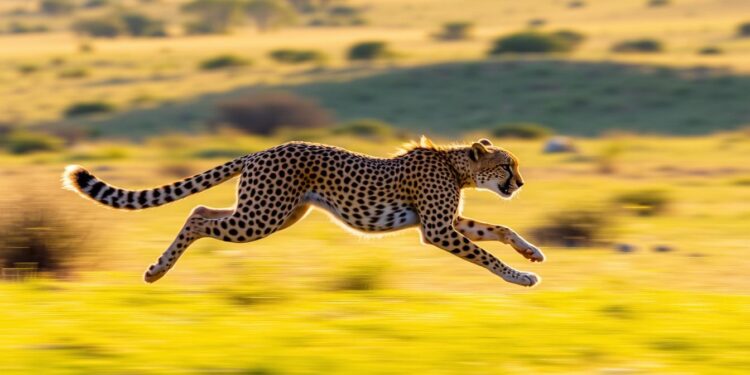The cheetah is known as the fastest land animal. It’s a standout in feline evolution. It’s a cheetah daytime hunter, hunting in the day for its great eyesight and speed. This unique cheetah behavior lets it live in grasslands of Eastern and Southern Africa, and parts of the Middle East. But, it faces threats from humans and other night hunters. With only about 7,100 left, we must keep up cheetah conservation efforts to save them.
Key Takeaways
- The cheetah is the fastest land animal, reaching speeds up to 60 mph.
- It primarily hunts during the day, showcasing unique hunting behaviors.
- Its exceptional eyesight helps it spot prey from great distances.
- Human-wildlife conflict and habitat loss threaten cheetah populations.
- Conservation efforts are vital to protect this iconic species.
- Understanding cheetah behavior can aid in effective conservation strategies.
Understanding the Cheetah’s Unique Behavior
The cheetah is special among big cats for its day-hunting ways. It uses its speed and sharp eyes to hunt. This lets it live well in its home.
Diurnal Hunting Patterns
Cheetahs hunt in the morning and late afternoon. This time helps them avoid other predators like lions and leopards. They also match when their prey is most active.
Their speed is key to catching animals like gazelles. They can see prey from far away. This helps them catch their food more often.
Comparison with Other Big Cats
Unlike cheetahs, lions and tigers hunt at night. They use stealth, not speed. Cheetah cubs learn to hunt by watching their mothers. This shows how important their hunting ways are for them.
Cheetah Daytime Hunter: Master of Speed and Agility
Cheetahs are amazing animals, made for daytime hunting. They have special bodies that help them be the fastest on land. Their light build and strong muscles let them run super fast and be very agile.
Physical Adaptations for Speed
The cheetah’s speed and agility come from special body parts. Key features include:
- Lightweight Body Structure: This makes them fast to start moving.
- Long Legs: These help them take big strides, making them faster.
- Flexible Spine: A special spine lets them stretch more when they run, which helps them go faster.
- Semi-Retractable Claws: These claws give them a good grip and traction for quick turns, which is key for catching prey.
These special features help the cheetah run very fast and stay fast. This makes them one of the fastest animals on land.
Exceptional Hunting Techniques
Cheetahs also have special ways of hunting during the day. Their hunting methods are:
- Stalking: They use sharp eyesight to find prey from far away, then sneak up until they can attack.
- Sprinting: When it’s time, they run super fast, over 60 mph, for about 20 seconds.
- Strategic Approach: They use their agility to move quietly and get into the best position for chasing their prey.
These skills are crucial for cheetahs to catch food in their big African homes.
The Cheetah’s Specialized Hunting Techniques
Cheetahs have amazing hunting skills that fit their home perfectly. They use stalking and sprinting to catch small animals, like antelopes. These methods show how cheetahs do well in the savanna.
Stalking and Sprinting
They start by stalking quietly. Cheetahs move fast but stay low to not be seen. When close enough, they sprint at speeds up to 60 miles per hour. This fast move comes after careful planning, and using their best hunting skills.
Use of Vision in Hunting
Good vision is key for cheetahs when hunting. They can see prey from over two miles away. This sharp sight helps them plan their attack and sprint at the right time. It makes them more likely to catch their prey.
Tracking Cheetahs in Their Habitat
Cheetahs live in many places across Africa. They like the grasslands of Eastern and Southern Africa. They also live in some areas in the Middle East. Knowing where they live helps us track them and keep them safe from dangers.
Geographic Range and Habitat Preferences
These amazing animals love open plains, savannas, and grasslands. They like places with not too much vegetation. This lets them run fast and see their prey easily. But, they’re losing their homes because of farms and cities.
This makes it hard for them to live and hunt. They have less space and struggle to find food.
Interactions with Other African Wildlife
Cheetahs work together with other animals in their world. They often compete with big predators like lions and leopards. This can be a danger to their babies.
Watching cheetahs shows how important they are to the food chain. If there are fewer cheetahs, their prey might grow too big. This could harm many other animals in Africa.
| Key Factors Influencing Cheetah Habitat | Description |
|---|---|
| Habitat Type | Prefer open plains and savannas for easy hunting. |
| Competition | Face threats from larger predators, affecting survival rates. |
| Human Impact | Habitat loss from agriculture and urban development. |
| Ecological Role | Keep prey populations in check, essential for ecosystem balance. |
| Conservation Efforts | Focus on habitat protection to ensure long-term survival. |
Conclusion
The cheetah is a true marvel of nature, living in the African savanna. They are known for their speed and hunting skills. But, they face big threats like losing their homes and conflicts with humans.
To save this amazing animal, we need strong conservation efforts. We must work on saving their homes, teach people, and find ways to reduce conflicts. This will help cheetahs survive.
Learning about the challenges cheetahs face is important. It helps us protect this iconic cat and keep their homes safe. We must talk about how to save cheetahs to get support for their protection.




